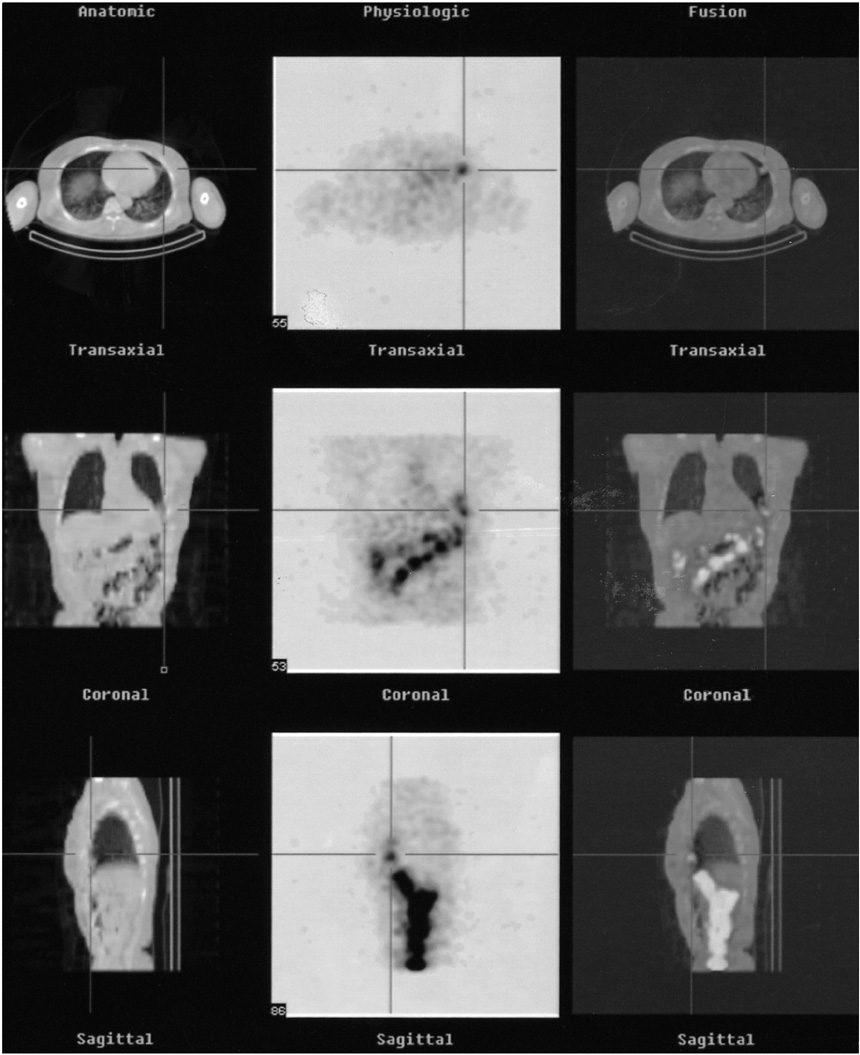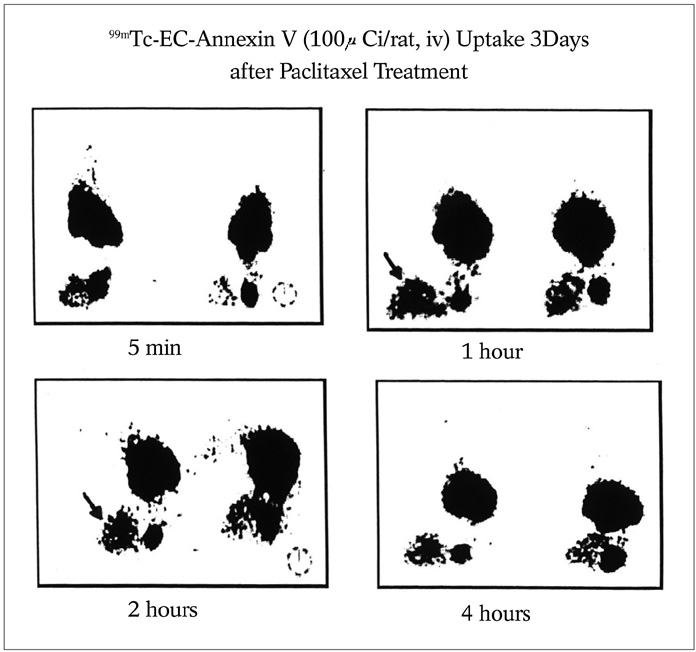Korean J Radiol.
2003 Dec;4(4):201-210. 10.3348/kjr.2003.4.4.201.
Targeted Molecular Imaging
- Affiliations
-
- 1Department of Radiology and Medicine, Center for Metabolic Imaging, Nuclear Medicine, The University of Texas MD Anderson Cancer Center, Houston, TX 77030 USA. ekim@di.mdacc.tmc.edu
- KMID: 1111248
- DOI: http://doi.org/10.3348/kjr.2003.4.4.201
Abstract
- Molecular imaging aims to visualize the cellular and molecular processes occurring in living tissues, and for the imaging of specific molecules in vivo, the development of reporter probes and dedicated imaging equipment is most important. Reporter genes can be used to monitor the delivery and magnitude of therapeutic gene transfer, and the time variation involved. Imaging technologies such as micro-PET, SPECT, MRI and CT, as well as optical imaging systems, are able to non-invasively detect, measure, and report the simultaneous expression of multiple meaningful genes. It is believed that recent advances in reporter probes, imaging technologies and gene transfer strategies will enhance the effectiveness of gene therapy trials.
MeSH Terms
Figure
Reference
-
1. Weissleder R, Mahmood U. Molecular imaging. Radiology. 2001. 219:316–333.2. Pennisi E. Human genome: finally, the book of life and instructions for navigating it. Science. 2000. 288:2304–2307.3. Marshall E. Gene therapy on trial. Science. 2000. 288:951–957.4. O'Malley BW Jr, Couch ME. Gene therapy principles and strategies for head and neck cancer. Adv Otorhinolaryngol. 2000. 56:279–288.5. Wilson JM. Adenoviruses as gene-delivery vehicles. N Engl J Med. 1996. 334:1185–1187.6. Robbins PD, Ghivizzani SC. Viral vectors for gene therapy. Pharmacol Ther. 1998. 80:35–47.7. Chmura SJ, Advani SJ, Kufe DW, Weichselbaum RR. Strategies for enhancing viral-based gene therapy using ionized radiation. Radiat Oncol Investig. 1999. 7:261–269.8. Chen EA. A comtemporary review of gene therapy and its applications. Applied Radiology. 2001. 30:36–48.9. Boerman OC, Oyen WJ, Corstens FH. Progress in gene therapy: seeing is believing. J Nucl Med. 2001. 42:1235–1237.10. Tuting T, Storkius WJ, Lotze MT. Gene-based strategies for the immunotherapy of cancer. J Mol Med. 1997. 75:478–491.11. Arai H, Gordon D, Nabel EG, Nabel GJ. Gene transfer of Fas ligand induces tumor regression in vivo. Proc Natl Acad Sci U.S.A. 1997. 94:13862–13867.12. Roth JA, Nguyen D, Lawrence DD, et al. Retrovirus-mediated wild-type p53 gene transfer to tumors of patients with lung cancer. Nature Med. 1996. 2:985–991.13. Ogawa N, Fujiwara T, Kagawa S, et al. Novel combination therapy for human colon cancer with adenovirus-mediated wild-type p53 gene transfer and DNA-damaging chemotherapeutic agent. Int J Cancer. 1997. 73:367–370.14. Barnes MN, Deshane JS, Rosenfeld M, Siegal GP, Curiel DT, Alvarez RD. Gene therapy and ovarian cancer: a review. Obstet Gynecol. 1997. 89:145–155.15. Feldman AL, Libutti SK. Progress in antiangiogenic gene therapy of cancer. Cancer. 2000. 89:1181–1194.16. Ramesh R, Marrogi AJ, Munshi A, Abboud CN, Freeman SM. In vivo analysis of the bystander effect: a cytokine cascade. Exp Hematol. 1996. 24:829–838.17. Rosenberg RA. Cancer vaccines based on the identification of genes encoding cancer regression antigens. Immunol Today. 1997. 18:175–182.18. Guinan EC, Gribben JG, Boussiotis VA, Freeman GJ, Nadler LM. Pivotal role of the B7/CD28 pathway in transplantation tolerance and tumor immunity. Blood. 1994. 84:3261–3282.19. Corr M, Tighe H, Lee D, et al. Costimulation provided by DNA immunization enhances antitumor immunity. J Immunol. 1997. 159:4999–5004.20. Freeman SM, Whartenby KA, Freeman JL, Abboud CN, Marrogi A. In situ use of suicide genes for cancer therapy. Semin Oncol. 1996. 23:31–45.21. Haberkorn U, Oberdorfer F, Gebert J, et al. Monitoring gene therapy with cytosine deaminase: in vitro studies using 3H-5-fluorocytosine. J Nucl Med. 1996. 37:87–94.22. Thomas JW, Kuo MD, Chawla M, et al. Vascular gene therapy. RadioGraphics. 1998. 18:1373–1394.23. Hogemann D, Basilion JP. Seeing inside the body: MR imaging of gene expression. Eur J Nucl Med Mol Imaging. 2002. 29:400–408.24. Misslitz A, Mottram JC, Overath P, Aebischer T. Targeted integration into a rRNA locus results in uniform and high level expression of transgenes in Leishmania amastigotes. Mol Biochem Parasitol. 2000. 107:251–261.25. Seul KH, Beyer EC. Mouse connexin 37: gene structure and promoter analysis. Biochim Biophys Acta. 2000. 1492:499–504.26. Gambhir SS, Bauer E, Black ME, et al. A mutant herpes simplex virus type 1 thymidine kinase reporter gene shows improved sensitivity for imaging reporter gene expression with positron emission tomography. Proc Natl Acad Sci U.S.A. 2000. 97:2785–2790.27. Haberkorn U, Oberdorfer F, Gebert J, et al. Monitoring gene therapy with cytosine deaminase: in vitro studies using 3H-5-fluorocytosine. J Nucl Med. 1996. 37:87–94.28. MacLaren DC, Gambhir SS, Satyamurthy N, et al. Repetitive, non-invasive imaging of the dopamine D2 receptor as a reporter gene in living animals. Gene Ther. 1999. 6:785–791.29. Iyer M, Barrio JR, Namavari M, et al. 8-[18F] fluoropenciclovir: an improved reporter probe for imaging HSV1-tk reporter gene expression in vivo using PET. J Nucl Med. 2001. 42:96–105.30. Zinn KR, Chaudhuri TR. The type 2 human somatostatin receptor as a platform for reporter gene imaging. Eur J Nucl Med Mol Imaging. 2002. 29:388–399.31. Zinn KR, Chaundhuri TR, Krasnykh VN, et al. Gamma camera dual imaging with a somatostatin receptor and thymidine kinase after gene transfer with a bicistronic adenovirus in mice. Radiology. 2002. 223:417–425.32. Becker A, Hessenius C, Licha K, et al. Receptor-targeted optical imaging of tumors with near-infrared fluorescent ligands. Nat Biotechnol. 2001. 19:327–331.33. Chung J-K. Sodium iodide symporter: its role in nuclear medicine. J Nucl Med. 2002. 43:1188–1200.34. Tazebay UH, Wapnir IL, Levy O, et al. The mammary gland iodide transporter is expressed during lactation and in breast cancer. Nat Med. 2000. 6:871–878.35. Turetschek K, Preda A, Floyd E, et al. MRI monitoring of tumor response following angiogenesis inhibition in an experimental human breast cancer model. Eur J Nucl Med Mol Imaging. 2003. 30:448–455.36. Yang DJ, Kim K-D, Schechter NR, et al. Assessment of antiangiogenic effect using Tc-99m EC-endostatin. Cancer Biother Radiopharm. 2002. 17:233–245.37. Schmitt CA, Lowe SW. Apoptosis and therapy. J Pathol. 1999. 187:127–137.38. Ogura Y, Krams SM, Martinez OM, et al. Radiolabeled annexin V imaging: diagnosis of allograft rejection in an experimental rodent model of liver transplantation. Radiology. 2000. 214:795–800.39. Rogers BE, Zinn KR, Lin CY, Chaudhuri TR, Buchsbaum DJ. Targeted radiotherapy with Y-90 SMT 487 in mice bearing human non-small cell lung tumor xenografts induced to express human somatostatin receptor type 2 with an adenoviral vector. Cancer. 2002. 94:1298–1305.





